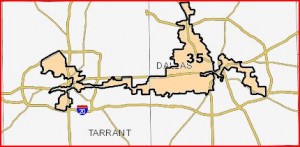Last week, MALDEF released a Congressional redistricting plan for Texas that was aimed at drawing two new Latino Congressional seats. Paul Burka has a complaint about one of the districts they drew.
The other district in Plan 108C is the new 35th district, one of the four new seats that Texas is scheduled to get. This is one strange-looking district. It looks like a man wearing a top hat, who is operating a front-end loader, with a wheelbarrow hooked on the rear.
The district is a case study of why it is hard to draw a Latino district. The population is too scattered and the geometry of the district looks like pieces of a jigsaw puzzle that fell out of the box. The MALDEF plan draws the district east and west along I-30, starting on the east at I-20 near Mesquite and Balch Springs. As the lines go west, the district is pulled spaghetti-thin in places. At the big highway interchange south of downtown Dallas, the district widens and turns onto a north-south axis to follow I-35E up to Farmer’s Branch. This includes a lot of Anchia’s current legislative district. Back on I-30, the bottom of the district resumes its westward course into Tarrant County. This is where it gets really thin, as it goes through Grand Prairie and Arlington. It connects with the western end of the front-end loader at the big highway intercharge south of downtown Fort Worth on I-35W.
Politico has some details about MALDEF’s plans, which you can see by going here – click on Select Plans, then Base Plans. It’s a bit of an overbid to call what MALDEF submitted a redistricting plan, since they only drew a handful of districts and left the rest of the state blank, to be filled in later. But for the record, here’s a view of the proposed CD35 that Burka writes about:
Honestly, I don’t see what the fuss is about. Is this really any worse than what was done in Travis or Harris Counties last time around? The 2003 DeLay map pairs Montrose with Tomball, Beaumont with Kingwood, and parts of Austin with northwest Harris County, South Texas, and north Bexar County. It joined Lubbock and Abilene against their will so Tom Craddick could have his own personal Congressman. It cracks and packs every minority community in Dallas and Tarrant so that only one Democrat can be elected from a delegation of eight. All of this was considered perfectly acceptable by the courts.
I do agree that compactness and communities of interest are important considerations when drawing a legislative map. But they’re not the only considerations, and to use compactness as an argument against drawing a map that reflects the strong Latino growth in Texas, without which we wouldn’t have all these new Congressional districts to fight over, is just wrong. As with Houston’s City Council map, the need to be just and fair to Texas’ underserved Latino population has to be weighed against the desire to keep geographical neighbors together. Not all communities of interest are next door to each other.


Kuff–Your title is extremely appropriate. They are just looking for excuses. Unfortunately, when I looked at the MALDEF maps, I was nearly positive that this excuse would come up. MALDEF should have drawn districts that are more compact and a little less Hispanic. The DFW district MALDEF drew is 70% Hispanic. They could have easily drawn the following that I drew for my prediction map at SSP:
The Green district in this case is 64% Hispanic. That is still safely Hispanic and would likely elect a representative like Anchia. It’s also much more compact. It however has a larger Black population (18% versus 12% in the MALDEF map.) If one were to allow even more Blacks and fewer Hispanics, then they could make it even more compact.
There is still time. I think that MALDEF (or someone) should submit a map with whole bunch of compact slightly-less-Hispanic Hispanic opportunity districts. That way if they are diluted (and let’s face, they will be), then they would have a clear path for a Gingles challenge.
Rats the image in my previous comment did not show up like I had hoped.
Click here for a direct link to the Green DFW district mentioned previously.
This is a silly contorted race based district, and in my view, would violate Shaw v. Reno. You should post a map of the current 7th District, which you suggest is comparable to this MALDEF proposed district. The 7th is compact. The fact that Montrose and far west Houston are in one district is not remarkable, for a district of such a size. The folks in Timbergrove and Lazybrook are paired in a district with 3rd Ward, and could be argued to be just as dissimilar, and many would be just as unhappy about their Congressman. The 29th stretches from near Hobby to near Intercontinental.
To further my point, the Pate map draws a Hispanic DFW district that is much more compact with a 64% Hispanic population, and the Owens maps draw a Hispanic DFW district that is 65.3%. In other words, just because the MALDEF DFW district is not particularly compact, Solomons could easily draw one that is. Because of Gingles, I think he has to.
Pingback: First State House redistricting plan is up – Off the Kuff